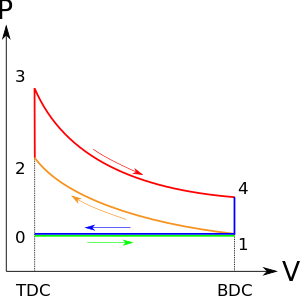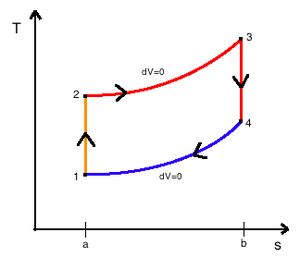The Diesel cycle is a combustion process of a reciprocating IC engine. It is invented by Rudolph Diesel in the year 1897. It is used in diesel engines. Today in this article we will know about its process in detail with its p-V and T-s diagrams.
Table of contents
p-V and T-s Diagrams
Maximum thermal efficiency
Difference between Diesel and Otto cycles
Table of contents
p-V and T-s Diagrams
Maximum thermal efficiency
Difference between Diesel and Otto cycles
p-V and T-s Diagrams of Diesel Cycle
The diesel cycle (combustion process) is similar to the Otto cycle.
 |
| p-V diagram |
To understand and learn the cycle fully we should refer its p-V and T-s diagrams.
 |
| T-s diagram |
Diesel cycle has the following four stages:
- Process 1-2 is Isentropic (Reversible adiabatic) Compression
- Process 2-3 is Constant Pressure (Isobaric) Heat Addition
- Process 3-4 is Isentropic Expansion
- Process 4-1 is Constant Volume (Isochoric) Heat Rejection
The maximum thermal efficiency of the Diesel cycle
The maximum thermal efficiency of a Diesel cycle depends on the compression ratio and the cut-off ratio. Air-standard efficiency (or thermal efficiency) of the diesel cycle is given by:
ηTh=1-(1/rγ-1) ((αγ-1)/(γα-γ))
where
ηTh is the thermal efficiency
α is the cut off ratio
γ is the ratio of specific heats
ηTh is the thermal efficiency
α is the cut off ratio
γ is the ratio of specific heats
Difference between Diesel and Otto cycles
Invented by Nicolas Otto in 1897, the Otto cycle is an idealized thermodynamic cycle for spark ignition engines. We have discussed above the steps included in an ideal diesel cycle. For otto-cycle, the steps are somewhat similar,
- 1–2 is the isentropic compression of air in the cylinder.
- 2–3 is the constant volume heat addition.
- 3–4 is the isentropic expansion of air.
- 4–1 is the constant volume heat rejection.
Please refer to Pressure-Volume and Temperature-Entropy diagram below.
 |
| p-V diagram (Otto cycle) |
 |
| T-s diagram (Otto cycle) |
Other differences are discussed below in the table.
Sr. No.
|
OTTO CYCLE
|
DIESEL CYCLE
|
1
|
Heat addition is isochoric (constant volume)
|
Heat addition is isobaric (constant pressure)
|
2
|
It is used in petrol engines
|
It is used in diesel engines
|
3
|
Compression ratio is 7:1 to 10:1.
|
Compression ratio 11:1 to 22:1 which is more than Otto.
|
4
|
Less efficient
|
More efficient
|
5
|
The complete backward stroke of the piston triggers the adiabatic expansion.
|
The adiabatic expansion happens during the rest part of stroke after the heat addition is cut-off in the backward stroke.
|











No comments:
Post a Comment